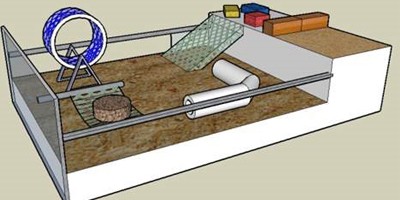Rat Model Application for Dog Training
Assistant Professor Avi Avital is taming rats to detect explosives and construct animal models as a working platform for the treatment of diseases such as schizophrenia.
Assistant Professor Avi Avital from the Technion’s Rappaport Faculty of Medicine, is training rats in an attempt to build (along with Professors Moshe Gabish and John Finberg) – a working model for the treatment of neurodegenerative diseases such as Parkinson’s and Huntington. He recently built a working model to validate symptoms of schizophrenia: “We gave rats a low sub-anesthetic dose of ketamine (a veterinary anesthetic) and exposed them to stress to build a working model for the treatment of schizophrenia – for an understanding of the factors responsible for disease outbreak and experimental platforms for drug development.”
As part of an applied research study, Assistant Professor Avital succeeded in taming rats to detect explosives. “Rats have a highly developed sense of smell and we succeeded in taming them to identify scents of explosive materials,” he said. “The insights from a study of rat models are being implemented in dog training in a collaborative study with the Israel Ministry of Defense and the United States Army (USA).”
“In an extensive mapping study we conducted, we exposed rats to stress at different periods of their lives, and we found that the critical period for exposure to stress is during the same transition period between childhood and adolescence in humans,” he said.
On the account of an NIH grant from the American Defense Department, Assistant Professor Avital built a sophisticated laboratory of behavioral biology, which is studying rats mainly in the area of attention and social interaction, in combination with behavioral aspects of physiological and pharmacological research. In parallel of performing his clinical research, which he conducts at the Emek Medical Center in Afula, he continues his work with dogs. Recently, he developed a device that simulates explosive materials as part of a systematic and safe dog training process. In this field he newly demonstrated the importance of the link between stress level and attention of a dog’s customary ability to execute various tasks. He also found that if the dog detects one type of explosive, he is capable of generalizing and identifying other types of explosives. “We have shown that this ability to generalize is found in the same brain region of both dogs and rats,” he explained.
Assistant Professor Avital developed a way to train rats through behavioral shaping procedures. He clothes rats with a “vest” that is connected to tiny metals imbedded under the rat’s skin (using a minimal-pain procedure). The rat feels a light tap – he taught them that when the tap is felt on the right hand side to turn left, and vice versa. When tapping both shoulders, the rat will stop, etc.
In the study investigating social cooperation, Assistant Professor Avital built a labyrinth that is controlled automatically by software and a camera through which rats learn social cooperation. “Female rats cooperate better than males,” he emphasized.
Assistant Professor Avital’s work is unique because it is beyond translational science (circumspect conclusions of a rat model to humans); he conducts half translational science, that is: he makes inferences from one animal (rats) to another (dogs). Using behavioral, physiological and pharmacological methods, Assistant Professor Avital focuses on attention and social cooperation in all research levels aforementioned.
In the photo:
A lab rat and an illustration depicting the laboratory and Assistant Professor Avital’s work methods.
The video displays a rat dressed in a “vest.”



